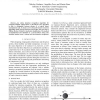9 search results - page 1 / 2 » Online Intention Recognition in Computer-Assisted Teleoperat... |
HAPTICS
2010
IEEE
13 years 11 months ago
2010
IEEE
Limitations of state-of-the-art teleoperation systems can be compensated by using shared-control teleoperation architectures that provide haptic assistance to the human operator. T...
ICRA
2010
IEEE
13 years 9 months ago
2010
IEEE
— An online intention recognition algorithm for computer-assisted teleoperation is introduced. The algorithm is able to distinguish between phases of a typical object manipulatio...
RAS
2008
13 years 10 months ago
2008
Acquiring, representing and modeling human skills is one of the key research areas in teleoperation, programming-by-demonstration and human-machine collaborative settings. The pro...
KI
2010
Springer
13 years 8 months ago
2010
Springer
Recognizing human intentions is part of the decision process in many technical devices. In order to achieve natural interaction, the required estimation quality and the used comput...
HAPTICS
2002
IEEE
14 years 3 months ago
2002
IEEE
We present the results of using Hidden Markov Models (HMMs) for automatic segmentation and recognition of user motions. Previous work on recognition of user intent with man/machin...


